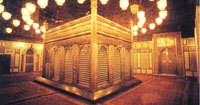What to Look for in Fine Art [Archives:1998/04/Culture]
Dr. Omar Saleh, vice- general of the Halaqa spoke on the types of buyers that buy Yemeni work. He said that 70% of the buyers are European but there are also people from the foreign ministries, the ministry of culture, government establishments and Yemeni businesses. Not all buyers are connoisseurs, some want just to have a momento of the country. The Ministry of Culture buys some to encourage Yemeni art. As far as professionals are concerned, people like doctors buy paintings that represent modern schools like the post-modernists. Businessmen on the other hand tend to prefer classical art forms and realistic art. I am reminded of the art forms I noticed at Italian businesses, like the Banca Nazionale di Lavoro in Italy where there are prints from the more traditional Canaletto scenes of old Venice to Kandinsky’s metaphoric symbol- like paintings.
Encouragement came recently in the form of an exhibit held last month when a syndicate of plastic artists was formed. There are repetitive elements which artists use and that can somehow represent a sort of artistic signature. The horse is a common symbol representing knighthood in this country, much like the bundle of grain depicted in a Ukrainian artist’s painting would symbolize abundance. Yemeni artists like foreign ones like to experiment with the use of space. The abstract is popular in Yemen as there is the urge to examine age-old themes like mother and child scenes or the woman in various poses, through the abstract. These are the painting subjects which sell the world over. Amin Nasher, who did Women I and II, used bits of cloth attached to full length painted boards which portrayed his women. Other artists are less abstract and more naif like Abdullah Amin’s depiction of the old city of Sanaa. The city forms are kept but the colors emanate from the fantasy-world of the artist. In “embracing” and other works by by Makrami, the human outline is visible as the artist wants to employ dark lines to relate movement. Dr. Veerman’s works represent the inner world of the mind as it plays an eternal game of chess.The chessboard is his repeated theme. Do Yemenis have a style particularly different from that of foreign artists? Not in the least suggested Saleh. Many have been abroad to foreign schools and have been educated and influenced there. It’s well known that any artist who wants to get ahead gradually has to discover a niche of his own, something that people can identify with. But most are influenced by the great European artists and that shows in their paintings.
Of the recent December exhibition at the Halaqa, 30% of the paintings sold including works from both Yemenis and foreigners. Many of the Yemeni artists have their workshops at the Bab al-Yemen. Foreign artists are also encouraged to participate at Halaqa exhibitions; 10 % goes to the center for members and 15% goes to the center for non-members.
Martin Dansky/ Yemen Times
——
[archive-e:04-v:1998-y:1998-d:1998-01-26-p:./1998/iss04/culture.htm]


